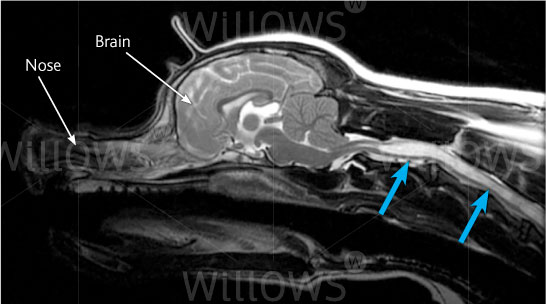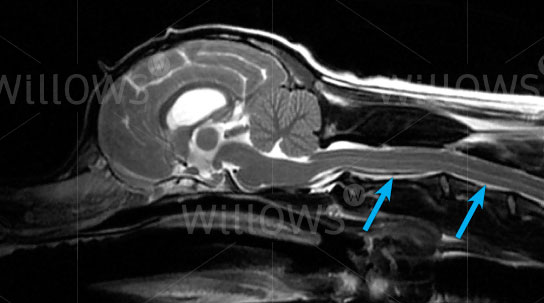Why Should I Bring my Pet to Willows for Investigation and Management of Syringomyelia?
Willows is one of Europe’s leading small animal referral centres. Our state-of-the-art hospital is led by internationally renowned Specialists, committed to providing the highest standards of veterinary care. Our Specialist Neurosurgeons are supported by our multi-disciplinary team of Specialists across a number of different disciplines including; Anaesthesia, Diagnostic Imaging and Emergency and Critical Care.
Willows also has a large dedicated team of Vets, Nurses and clinical support staff available 24 hours a day, every day of the year to provide the best possible care for your pet. This combination of exceptional facilities and expertise allows Willows to provide the most accurate diagnosis and optimal care for any patient with syringomyelia.
What is a Faint or a Fit?
“Collapse” is a generic term used to describe an episode of falling down or recumbency, which can either be brief or for a long period of time, these are often referred to as seizures.
What are the Most Common Causes of Faints or Fits?
The causes of collapsing can be as a result of a number of conditions such as an abnormal heart rhythm disorder (faint/syncope), seizures (fits), medical conditions such as low blood glucose or an imbalance in electrolytes.

What is Syringomyelia?
Syringomyelia is a neurological condition where fluid filled cavities develop within the spinal cord (the bundle of nerves that run inside the spine). The most common reason for the fluid build-up is that there is an abnormality where the skull joins onto the bones of the spine (vertebrae) in the neck, causing fluid in the brain (called cerebrospinal fluid or CSF) to be forced down the centre of the spinal cord, where it causes the tissues to become enlarged and cavities to form.
Syringomyelia is a relatively common condition, especially in breeds like the Cavalier King Charles Spaniel and the Griffon Bruxellois, in which it is suspected to be an inherited disorder. Other names that have been used to describe this condition include syringohydromyelia, Arnold-Chiari or Chiari-like malformation, and caudal occipital malformation.
Fig 1: MRI scan of a patient with syringomyelia. The fluid build-up in the spinal cord shows as almost white (blue arrows).

What are the Most Common Signs of Syringomyelia?
Clinical signs can vary widely between dogs and there is no relation between the size of the syringomyelia and the severity of the signs; in other words a dog with severe fluid build-up can have relatively mild symptoms, and vice versa. The most common symptom that develops is intermittent neck pain, although back pain is also possible. Affected dogs may yelp and are often reluctant to jump and climb. They may feel sensations like ‘pins and needles’ (referred to as hyperaesthesia). Another common sign is scratching of the neck and shoulder region called ‘phantom scratching’, as there is generally no contact of the foot with the skin of the neck. Occasionally dogs become weak or wobbly if there is significant damage to nerves within the spinal cord. Cavalier King Charles Spaniels will typically show clinical signs between six months and three years of age. Not all dogs with syringomyelia will show signs of pain or other clinical symptoms, and so the presence of syringomyelia can be an incidental finding on an MRI scan. Other neurological conditions, such as slipped discs (cervical and thoracolumbar disc disease), can mimic the signs of syringomyelia and it is important for us to rule them out before concluding that your pet is suffering from syringomyelia.

How is Syringomyelia Diagnosed?
The best way of diagnosing syringomyelia is an MRI scan of the brain and spine. It is necessary to perform this investigation under a general anaesthetic. Patients undergoing an MRI scan for this condition are monitored by our Specialist team of Anaesthetists. In the future, it is possible there will be a genetic test to identify dogs with syringomyelia.
Fig 2: MRI scan of a patient with a normal spinal cord for comparison (blue arrows)

How can Syringomyelia be Treated?
Medical therapy is usually the treatment of choice in dogs suffering from syringomyelia. Several types of medication are used to manage episodes of pain, including a drug called gabapentin. This drug is safe, with few side effects apart from possible sleepiness. Other medications that may be used include anti-inflammatory drugs, corticosteroids and drugs that reduce the production of fluid in the brain and spinal cord.
Occasionally medical management is unsuccessful and surgery needs to be considered. The aim of surgery is to improve the shape of the back of the skull and reduce the flow of fluid down the centre of the spinal cord. Many dogs will improve following surgery, although some patients will have persistent signs despite surgery, whereas others may show improvement initially but then develop recurrence of their symptoms.
What can I Expect if my Pet is Treated for Syringomyelia?
Most patient will require ongoing medical management with pain relief. The treatment will be tailored to each patient and may need to be modified over time. A small proportion of dogs may not respond to medication and can have a significantly impaired quality of life. Should surgery be required our neurology-neurosurgery Specialists will discuss in detail the pros and cons of the surgical procedure and possible associated risks.
To save this page as a PDF, click the button and make sure “Save as PDF” is selected.
Neurology
Find out more
To assist owners in understanding more about Neurological conditions, investigations and treatment we have put together a range of information sheets to talk you through the some of the more common neurological conditions seen by our Specialists.

